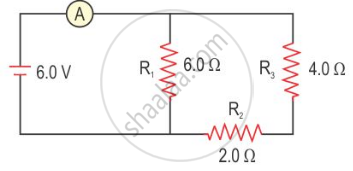Advertisements
Advertisements
Question
Three resistors of 6.0 Ω, 2.0 Ω and 4.0 Ω are joined to an ammeter A and a cell of emf 6.0 V as shown in the following figure. Calculate :
- the effective resistance of the circuit.
- the reading of ammeter.

Solution
From circuit diagram
R3 and R2 are in series
R3 = i.e 4 + 2 = 6 Ω
Now R3 and R1 are in parallel
- Total resistance = `1/"R" = 1/6 + 1/6`
= `2/6` or
R = `6/2 `
= 3 Ω - I = `"V"/"R"`
= `6.0/3.0`
= 2 A
APPEARS IN
RELATED QUESTIONS
Why is the series arrangement not used for domestic circuits?
Two resistors of 4Ω and 6 Ω are connected in parallel to a cell to draw 0.5 A current from the cell.
(i) Draw a labelled circuit diagram showing the above arrangement.
(ii) Calculate the current in each resistor. What is an Ohmic resistor?
Write down an expression for the resistance of a metallic wire in terms of the resistivity.
Calculate the resistance of an aluminium cable of length 10 km and diameter 2.0 mm if the resistivity of aluminium is 27 × 10−8 Ωm.
What material is used for making wire to prepare heating coils? Give a reason.
How does the resistivity of a semiconductor depend on temperature?
State expression for Resistance connected in series.
Write an expression for calculating electrical power in terms of current and resistance.
Two resistors having 2Ω and 3Ω resistance are connected—(i) in series, and (ii) in parallel. Find the equivalent resistance in each case.
